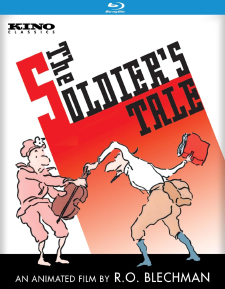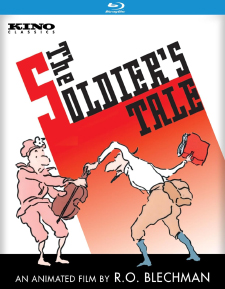Soldier’s Tale, The (Blu-ray Review)

Director
R.O. Blechman, Christian BlackwoodRelease Date(s)
1984 (March 19, 2024)Studio(s)
R.O. Blechman Inc./WGBH (Kino Classics)- Film/Program Grade: B
- Video Grade: B+
- Audio Grade: B-
- Extras Grade: B+
Review
Composer Igor Stravinsky had achieved fame by 1918 with his ballet scores for The Firebird, Petrushka, and The Rite of Spring, but the Russian Revolution and World War I dealt a serious blow to his wealth and income. He went into exile in Switzerland, where a Swiss philanthropist offered him a commission to compose the music for The Soldier’s Tale, a theatrical work written by C.F. Ramuz that combined actors, musicians and dancers and blended classical music with jazz. In 1984, animator R.O. Blechman created an animated version of The Soldier’s Tale for WGHB, Boston’s PBS station.
The story is based on a Russian folktale. A soldier on leave is looking forward to marrying his sweetheart and raising a family. These plans are interrupted by a strange old man catching butterflies who expresses an interest in buying the soldier’s violin. Reluctant at first, the soldier eventually agrees to a deal with the old man. The soldier will give his violin to the old man in exchange for a book that foretells the future and guide the soldier to great prosperity. The butterfly collector is actually the Devil in disguise and the tale proceeds along Faustian lines.
Max von Sydow brings an ominous presence to the film as the voice of the Devil — a dark version of Harold Hill, a huckster who knows how to dish out the perfect con. Unlike Hill, however, the Devil lacks charm. His offer to the soldier seems too good to be true, but the Devil has the gift of gab and never doubts his ability to get what he wants. Von Sydow infuses the Devil with a generous helping of menace. Other notable voice talent includes Andre Gregory as the narrator, Brother Theodore (the stage name of Theodore Gottlieb, a comedian and TV personality), Russian ballerina Galina Panova as the princess, and Mike Mearian as the announcer.
A narrated prologue showing stark black & while newsreel photos briefly chronicles events that led to the creation of The Soldier’s Tale and includes a brief overview of Igor Stravinsky’s career. This mini-history lesson leads directly into the story.
The Soldier’s Tale is a visual treat. Most of the film is drawn in Blechman’s clear-line style, with animation that’s intentionally jerky. The world created by Blechman looks like pages out of a child’s book of fairy tales, with bold colors bursting from the screen. Several animators are credited, among them Tessa David, Fred Mogubgub, Tony Eastman, Bill Littlejohn, and Yvette Kaplan. This multi-artist approach is reminiscent of Disney’s Fantasia, in which individual sequences were assigned to different groups of artists. Some sequences reminded me of the surrealistic animation in the Beatles’ Yellow Submarine.The incorporation of diverse styles provides the film with considerable variety, and brisk editing matches images to Stravinsky’s rhythms.
The darker parts of the Stravinsky/Ramuz piece have been smoothed over, likely because it was made for television, but it still is a powerful comment on war and its aftermath. The tone is lighter and the animated characters contribute to the more family-friendly approach. The narrative occasionally gets a bit confusing but usually gets back on track. The one-hour running time evidently was dictated by the music but is just right for the tale. The film also is quite accessible, not merely a highbrow curiosity.
The Soldier’s Tale was shot in color on 35 mm film and presented in the aspect ratio of 1.33:1. The Blu-ray was restored in 2K from R.O. Blechman’s personal 35 mm print. Clarity is very good and the color palette varied, ranging from simple monochrome drawings to extremely detailed and colorful sequences. The film was designed by Blechman. Thirty-nine animators contributed their talent. A six-person team created the film’s visual effects with airbrush renderings. The simulated camera work is excellent, with many scenes filled with elaborate movements, interesting use of perspective, multiple screens, zooms, and kaleidoscopic designs. In the simpler sequences, only a bit of color is added to line drawings, while other sequences are rendered in bright, rainbow-like hues.
The soundtrack is English 2.0 DTS-HD Master Audio. English SDH subtitles are an available option. The score, performed by the Los Angeles Chamber Orchestra, is essential to the film, but all the sounds seem to run together, offering little ability to perceive specific instruments. In a film so dependent on music, this is a disappointment. Stravinsky’s often eccentric rhythms do enliven the visuals and contribute palpable atmosphere. The well chosen voice talent provides just the right amount of narration, letting the visuals and the music drive the story.
Bonus features on the Region A Blu-ray release from Kino-Lorber include the following:
- Audio Commentary by Director R.O. Blechman, Animator Tessa David, and Associate Producer George Griffin
- No Room at the Inn (13:39)
- The Hand of R.O. Blechman (17:20)
- Theatrical Re-Release Trailer (:44)
Audio Commentary – Parts of R.O. Blechman’s 35 mm print have been included in this 2K restoration that were not included in an earlier video release. Director Blechman talks about pencil tests matching the music perfectly, and comments on the various techniques used to achieve certain effects. Andre Gregory was chosen as one of the voices because he could sound European. Credit is given by name to individual artists who worked on specific sequences. Sometimes drawings do not come out quite right. “The draftsmanship is rough.” Blechman confesses that there are ways of covering for imperfect animation, such as adding confetti or snow. The metaphoric significance of the butterfly is explained. Describing his method of working, Blechman notes that he blocks out a scene and then the animators embellish it. The film has a “kinetic quality” provided by a distinctive jerkiness in the movement of characters. Maxfield Parrish was an influence on the style of some sequences. Others were created with an eye toward budgetary limitations and time constraints. With little narration, action in The Soldier’s Tale speaks for itself. Blechman emphasizes that “it’s important to have the right people working with you.”
No Room at the Inn – This short film by R.O. Blechman features simple line drawing animation and is mostly in black & white with a brief splash of blue. It’s the story of Joseph and Mary heading into Bethlehem but finding all lodgings closed to them. They take refuge in a stable to shelter from a raging storm. Told in pantomime with only music and sound effects, the film is a simple adaptation of the Nativity.
The Hand of R.O. Blechman – This is a series of short works by R.O. Blechman, primarily commercials and short films. The commercials include those for Alka Seltzer, Volvo, Perrier, CBS, Angelika Theaters, and WQXR-FM. The short films include an adaptation of The Transformation of Lucius, The Medical Dilemma, a children’s film about the letters “O” and “A,” and Exercise.
The Soldier’s Tale is significant in its marriage of animation and classical music on film. The story resonates because of its simplicity, but its message often overbearing. At just under an hour, the film contains forays into surrealistic alternate realities that might throw viewers off. This is not classic Disney animation with cute, rounded creatures and life-like movement. With its deceptively simple visuals, the film explores temptation, forbearance, and perseverance in the face of self-doubts and indecision.
- Dennis Seuling

